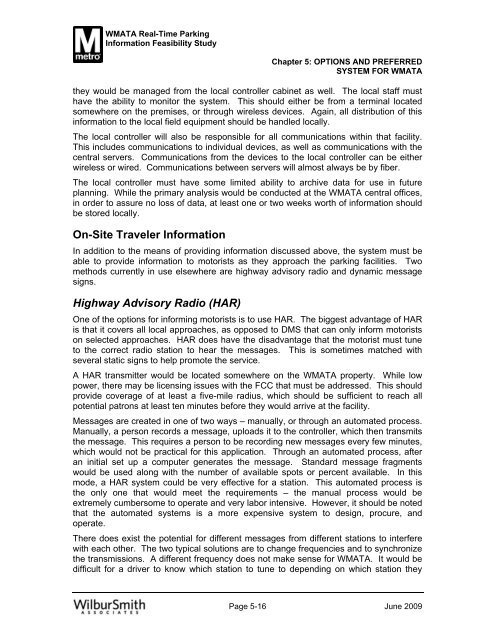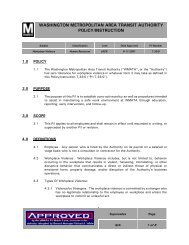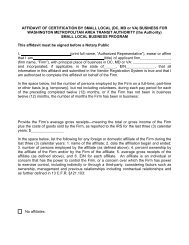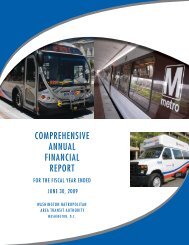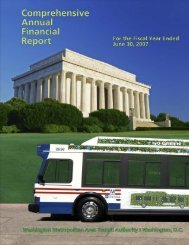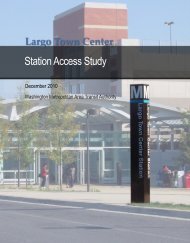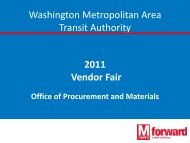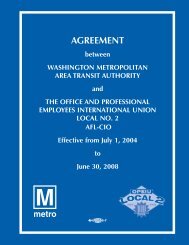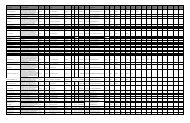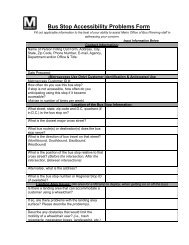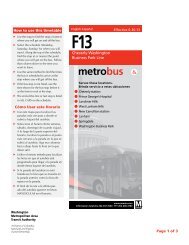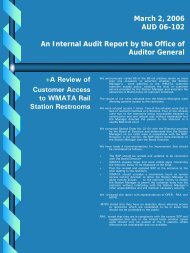feasibility study of real time parking information at ... - WMATA.com
feasibility study of real time parking information at ... - WMATA.com
feasibility study of real time parking information at ... - WMATA.com
You also want an ePaper? Increase the reach of your titles
YUMPU automatically turns print PDFs into web optimized ePapers that Google loves.
<strong>WMATA</strong> Real-Time Parking<br />
Inform<strong>at</strong>ion Feasibility Study<br />
Chapter 5: OPTIONS AND PREFERRED<br />
SYSTEM FOR <strong>WMATA</strong><br />
they would be managed from the local controller cabinet as well. The local staff must<br />
have the ability to monitor the system. This should either be from a terminal loc<strong>at</strong>ed<br />
somewhere on the premises, or through wireless devices. Again, all distribution <strong>of</strong> this<br />
<strong>inform<strong>at</strong>ion</strong> to the local field equipment should be handled locally.<br />
The local controller will also be responsible for all <strong>com</strong>munic<strong>at</strong>ions within th<strong>at</strong> facility.<br />
This includes <strong>com</strong>munic<strong>at</strong>ions to individual devices, as well as <strong>com</strong>munic<strong>at</strong>ions with the<br />
central servers. Communic<strong>at</strong>ions from the devices to the local controller can be either<br />
wireless or wired. Communic<strong>at</strong>ions between servers will almost always be by fiber.<br />
The local controller must have some limited ability to archive d<strong>at</strong>a for use in future<br />
planning. While the primary analysis would be conducted <strong>at</strong> the <strong>WMATA</strong> central <strong>of</strong>fices,<br />
in order to assure no loss <strong>of</strong> d<strong>at</strong>a, <strong>at</strong> least one or two weeks worth <strong>of</strong> <strong>inform<strong>at</strong>ion</strong> should<br />
be stored locally.<br />
On-Site Traveler Inform<strong>at</strong>ion<br />
In addition to the means <strong>of</strong> providing <strong>inform<strong>at</strong>ion</strong> discussed above, the system must be<br />
able to provide <strong>inform<strong>at</strong>ion</strong> to motorists as they approach the <strong>parking</strong> facilities. Two<br />
methods currently in use elsewhere are highway advisory radio and dynamic message<br />
signs.<br />
Highway Advisory Radio (HAR)<br />
One <strong>of</strong> the options for informing motorists is to use HAR. The biggest advantage <strong>of</strong> HAR<br />
is th<strong>at</strong> it covers all local approaches, as opposed to DMS th<strong>at</strong> can only inform motorists<br />
on selected approaches. HAR does have the disadvantage th<strong>at</strong> the motorist must tune<br />
to the correct radio st<strong>at</strong>ion to hear the messages. This is some<strong>time</strong>s m<strong>at</strong>ched with<br />
several st<strong>at</strong>ic signs to help promote the service.<br />
A HAR transmitter would be loc<strong>at</strong>ed somewhere on the <strong>WMATA</strong> property. While low<br />
power, there may be licensing issues with the FCC th<strong>at</strong> must be addressed. This should<br />
provide coverage <strong>of</strong> <strong>at</strong> least a five-mile radius, which should be sufficient to reach all<br />
potential p<strong>at</strong>rons <strong>at</strong> least ten minutes before they would arrive <strong>at</strong> the facility.<br />
Messages are cre<strong>at</strong>ed in one <strong>of</strong> two ways – manually, or through an autom<strong>at</strong>ed process.<br />
Manually, a person records a message, uploads it to the controller, which then transmits<br />
the message. This requires a person to be recording new messages every few minutes,<br />
which would not be practical for this applic<strong>at</strong>ion. Through an autom<strong>at</strong>ed process, after<br />
an initial set up a <strong>com</strong>puter gener<strong>at</strong>es the message. Standard message fragments<br />
would be used along with the number <strong>of</strong> available spots or percent available. In this<br />
mode, a HAR system could be very effective for a st<strong>at</strong>ion. This autom<strong>at</strong>ed process is<br />
the only one th<strong>at</strong> would meet the requirements – the manual process would be<br />
extremely cumbersome to oper<strong>at</strong>e and very labor intensive. However, it should be noted<br />
th<strong>at</strong> the autom<strong>at</strong>ed systems is a more expensive system to design, procure, and<br />
oper<strong>at</strong>e.<br />
There does exist the potential for different messages from different st<strong>at</strong>ions to interfere<br />
with each other. The two typical solutions are to change frequencies and to synchronize<br />
the transmissions. A different frequency does not make sense for <strong>WMATA</strong>. It would be<br />
difficult for a driver to know which st<strong>at</strong>ion to tune to depending on which st<strong>at</strong>ion they<br />
Page 5-16 June 2009


